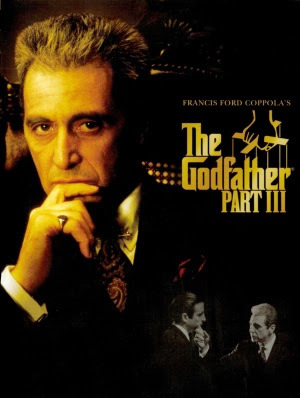Third Time’s Not the Charm: The Godfather, Part III

In 1972, everyone was talkingabout the screen version of Mario Puzo’s The Godfather. Who could forgetthe pageantry, the brutality, Marlon Brando stroking that cat? When awardsseason rolled around, The Godfather was nominated for eleven Oscars, winningBest Picture, Best Actor, Best Adapted Screenplay. (It was a great year formovies. In the Best Director category, Francis Ford Coppola was beaten out byBob Fosse and Cabaret.)
A mere two years later, asecond Godfather film showed up on movie screens. With Brando’s Vita Corleone dead and gone, GodfatherII focused on son and heir Michael (Al Pacino), now a reluctant crime bosstrying to reconcile himself to his new power. Michael’s story in the presentday is interwoven with that of Vito as a young man (Robert De Niro) leavingSicily in response to the massacre of his family. Unusually for a sequel, GodfatherII was perhaps even more admired by critics and audiences than the initialfilm. It was nominated for nine Oscars, and won an impressive six, becoming thefirst sequel ever to be named Best Picture, even though it was up against such masterworksas Chinatown.
You can’t blame ParamountPictures, which had optioned Puzo’s 1969 novel, for wanting to take fulladvantage of its golden goose, even though, after the release of GodfatherII, Coppola considered the Corleonesaga complete. That’s why Paramount hired a string of established writers anddirectors to come up with Part III. Some versions had the Corleones workingwith the CIA in Latin America. One involved a turf war with the Irish Mafia inAtlantic City. In another, Michael Corleone is killed early on, and the entirefocus is on his surviving children.
Some twenty years later, Puzoand Coppola were finally persuaded to return to the project, and much of theoriginal cast signed on. The focus is now entirely on an ageing Michael, stilltrying to balance his criminal activities with a desire to lead a worthy life.It’s striking to see what time has done to the familiar Corleone familymembers. Michael is greying and fighting health problems. His estranged wifeKay (Diane Keaton) has a rather silly new hairdo, and her sadness over the handshe’s been dealt is a bit hard to buy. (Since we’ve all seen Keaton be adorablyaddled in Annie Hall, it’s easy to think she’d face tragedy with ablithe and dithering la-di-da.) Michael’s sister Connie (Talia Shire), whom wefirst met as a jubilant bride in Part One, has been turned by circumstance intoa black-clad angel of death. New characters include Michael and Kay’s grownchildren. Son Anthony, who has turned his back on his father’s murderous ways,aspires to be an opera singer, and his stage debut in Palermo (in an opera thatfeatures Godfather-style violence) provides a nice excuse for the entirefamily to end up in Sicily. Daughter Mary (played by Coppola’s own daughter,future director Sofia) is her dad’s loyal sidekick. Her performance was muchderided back in the day, but the truth is that it’s a thanklessly unconvincingrole. And of course there are lots of thugs, connivers, andassassins-in-waiting. (Watch out if you see a cop or a priest on the streets;he’s probably a killer in disguise.)
What makes Godfather III worthwatching? Coppola is still brilliant at staging public spectacle: a street fair, a night at the opera, aninnocent-seeming place where danger lurks. Palermo and Manhattan both lookgorgeous. And the music—that plaintive trumpet theme—lures us into a story thatmight not be quite worth telling.
Beverly in Movieland
- Beverly Gray's profile
- 10 followers



